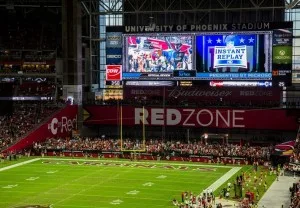Now that the “big game” is over, not without its last-minute drama – a few notes here on how the experience was consumed both inside and outside the University of Phoenix Stadium.

To those watching the game, you may have noticed the rather large end-zone display at the stadium. Outdoor display manufacturer Daktronics installed a new 1260 x 3836-pixel high definition LED video display, equivalent to two true high definition displays side by side, in the south end zone. Since 2006, Daktronics has installed a total of 18 individual LED video displays for the Arizona Cardinals – a total of more than 20,000 square feet (1858 m²).
The 13HD-series Daktronics display measures 58 feet (17.7 m) high by 164 feet (50 m) wide to provide an additional 9,512 square feet (885 m²) of live video and replays to fans inside the stadium. It incorporates a 13mm pixel-spacing layout for detailed imagery and includes high contrast technology for high image quality as well as wide viewing angles to service every seat in the stadium. The HD products have 1 red, 1 green, 1 blue LED in a proprietary layout using 3-in-1 SMD (surface mount device) LEDs. Calibrated brightness is 6,000-9,500 nits (cd/m²), depending on selected line spacing of different series products.
The display features variable content zoning, which allows them to show one large image to highlight live video and instant replays, and also multiple windows to show any combination of statistics, animations and game information as well as highlighting sponsor messages to a captive football audience. Daktronics products have been used at all of the past 11 Super Bowl venues, according to Daktronics national sales manager, Will Ellerbruch.
The NFL has also enhanced the in-stadium mobile experience for fans at the Phoenix stadium, with its first Super Bowl Stadium App by Verizon. The app offers ticketholders exclusive in-stadium video content such as all Super Bowl commercials and replays from four different camera angles. The app also includes seating and concession maps, limited-time gameday opportunities and the option to receive up-to-the-minute gameday notifications.
Also introduced for the 2014 NFL season are “Next Gen Stats,” providing real-time, location-based information such as speed and distance traveled, along with acceleration of individuals on the field. To enable “Next Gen Stats,” the NFL installed Zebra Technologies’ real-time location system (RTLS) for sports in 17 stadiums this season, and added an 18th system at University of Phoenix Stadium for the Pro Bowl and Super Bowl. These systems capture information in real-time via small radio-frequency identification (RFID) tracking devices on players and officials. The statistics and related graphics created from this data were displayed on in-stadium video boards during the Super Bowl. Additionally, for the first time, the NFL worked with Wilson to incorporate Zebra RFID devices into select games balls at the 2015 Pro Bowl. (It’s surprising that this was allowed, given the recent “deflated ball” ruckus.)
The NFL also worked with Extreme Networks to leverage its intelligent application analytics technology, Purview, to monitor and measure the mobile fan experience during the game. Extreme Networks also supplied “Wi-Fi Coaches” around the stadium to assist fans with connectivity questions and needs on gameday.
Following the launch of NBCUniversal’s first-ever TV Everywhere consumer campaign titled “Watch TV Without The TV,” NBCUniversal created “Super Stream Sunday,” which provided consumers with the ability to enjoy 11 continuous hours of NBC streaming content without having to log-in, designed as a way for consumers to trial NBC’s TV Everywhere content offering.
“Super Stream Sunday” content included NBC’s presentation of Super Bowl XLIX, Katy Perry headlining the Pepsi Super Bowl XLIX Halftime Show, the Super Bowl XLIX pre- and post-game shows, and NBC’s post-game presentation of the drama series The Blacklist. All Super Bowl content was streamed live to desktops and tablets via NBC Sports Live Extra, NBC Sports Digital’s live streaming product. However, NBC Sports Digital does not have NFL live streaming rights to mobile devices, so cellular customers were left in the dark, at least for now.
Large displays, handheld apps and live streaming to multiple devices continue to push content to sports fans everywhere – an experience that was once limited to in-person attendance or TV broadcast. Those holding consumption rights will have access to all that is offered – but content owners will still have business and rights issues that prevent ubiquitous accessibility. Don’t expect that to change overnight – or perhaps, ever? – Aldo Cugnini

